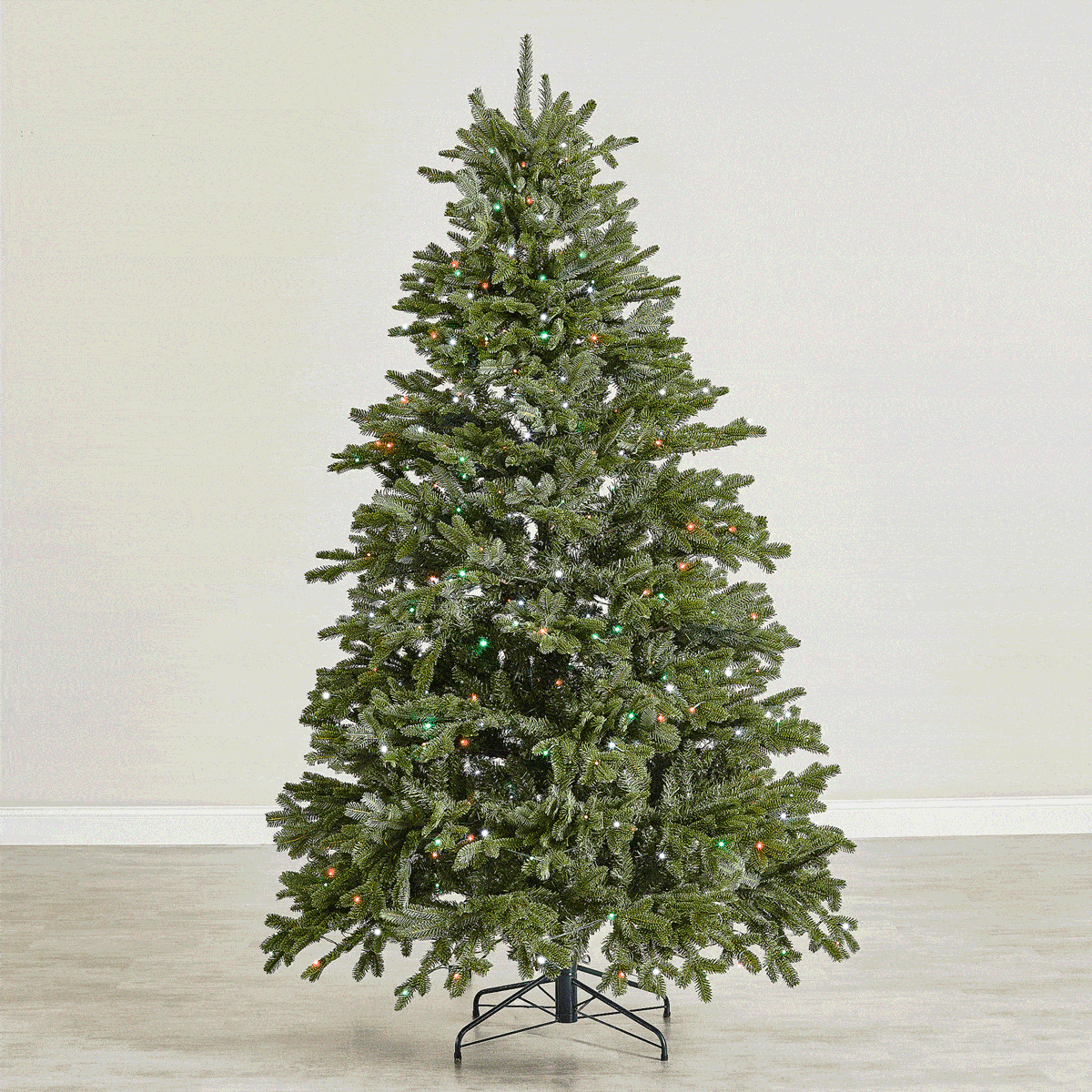 balsam hill classic blue spruce
balsam hill classic blue spruce
Best Overall
Classic Blue Spruce
We tested the Balsam Hill Classic Blue Spruce in our Milwaukee office, and it’s the best option for anyone craving a good ol’ fashioned Christmas tree. Our testers were in awe at the lifelike branches of the Blue Spruce, remarking that it reminded them of real trees from holidays past.
Assembly took less than four minutes for a 7.5-foot tree, and we loved that the lights connected with an easy plug. (AKA no fumbling in the branches trying to find a bunch of tiny connectors). It’s incredibly full, yet the branches are pliable for endless finessing. A word to the wise? Plan to fluff this tree for a long time. We spent a full 20 minutes on this tree and could have kept going.
The Blue Spruce is available in eight heights—ranging from 4.5 feet to a whopping 15 feet—and up to five light styles.

Pros
- Classic, full Christmas tree shape
- Incredibly lifelike, less “plasticky” than other trees we tested
- Eight height options
- Moderate price point
Cons
- Requires a lot of fluffing
- On the wobblier side
 balsam hill flip tree
balsam hill flip tree
Best Flip Tree
BH Balsam Fir Flip Tree
For a tree that sets up faster than you can say “sugarplum,” don’t sleep on the BH Balsam Fir Flip Tree. I’ve been testing this tree since July, and it’s an absolute must for easy holiday decorating.
It arrives at your door in a massive, refrigerator-style box. But once it’s inside, there’s no lifting required! Simply wheel it out, take off the protective bag, push the foot pedal and pull the tree towards you. In mere seconds, the base flips into place. Attach the top piece, plug it in and, voila! A fully assembled Christmas tree in less than two minutes.
This flip tree technology is exclusive to Balsam Hill. And we love the BH Balsam Fir version for its soft, lifelike needles and full stature. It’s available in four heights—6.5, 7.5, 9 and 10 feet—plus four light varieties.
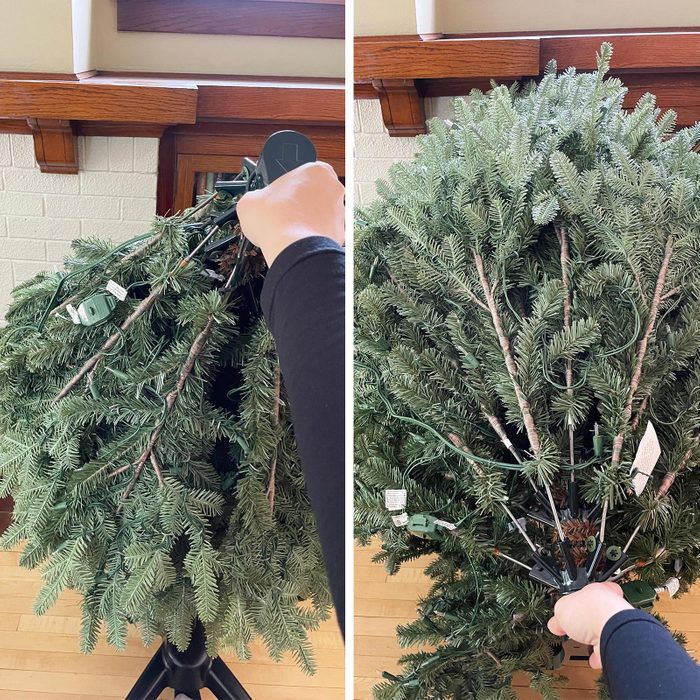
Pros
- Incredibly easy flip setup
- Moving stand requires no heavy lifting
- Four height options
- Includes premium storage bag
Cons
- Pricier option
 we tried smart twinkly tree
we tried smart twinkly tree
Best Smart Tree
BH Fraser Fir Tree with Twinkly Light Show
Another option we tested at Taste of Home HQ, the BH Fraser Fir Tree with Twinkly Light Show is a showstopper for anyone searching for the latest Christmas tree tech. This tree razzles and dazzles with over 500 Twinkly lights.
If you’re not familiar, Twinkly lights are controlled by an app and allow you to customize your tree with any light color, pattern and effect under the sun. In our testing, multiple editors spent hours identifying the coolest combos. We found the app is a little tricky to use and the lights have a blue undertone, but there’s truly no better option for colored light devotees. Learn more in our smart Christmas tree review.
The BH Fraser Fir pairs beautifully with the Twinkly lights, providing a sturdy base for ornaments, ribbon and other baubles. We love that this tree requires minimal fluffing so you can get straight to the fun part: decorating!
When paired with the Twinkly lights, this Balsam Hill tree is available in six heights, ranging from 5.5 feet to 12 feet. You can also opt for one of five other light options.
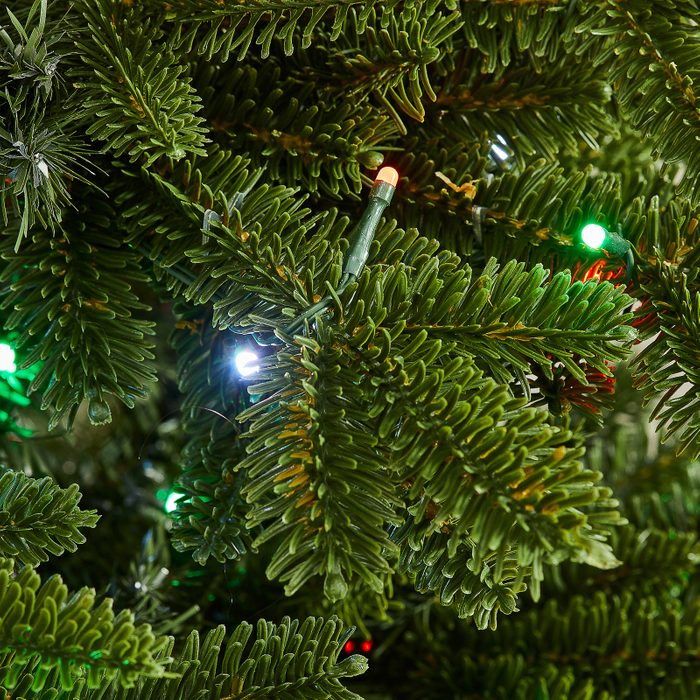
Pros
- Endless array of light colors and patterns
- Minimal fluffing required
- Six height options
- Lots of space for ornaments
Cons
- App can be a bit tricky to set up and use
 Balsam Hill Brewer Spruce
Balsam Hill Brewer Spruce
Best for Ornaments
Balsam Hill Brewer Spruce
Ornament lovers, this one’s for you. Over 4,379 tips on the 7.5-foot tree and over 6,315 tips on the 9-foot tree make the Balsam Hill Brewer Spruce a great option for serious holiday decorators. We love the slightly whimsical look of this tree, with branches fanning in different directions. Both light options for this tree are Easy Plug, so you can go from “meh” to “wow” in mere seconds.
Reviewers comment that this tree is fun to decorate, incredibly realistic and the wispy branches add an elegant touch. Opt for either a 7.5-foot or 9-foot tree with either Candlelight Clear LED lights or Color + Clear LED lights. Or, add some Balsam Hill floating tree candles.
Pros
- Unique tree shape
- More than 4,000 tips
- Downturned branches allow decorations to shine
- Incredibly lifelike
Cons
- Limited height and light options
 Silverado Slim
Silverado Slim
Best for Small Spaces
Silverado Slim
Looking for a tree that packs a punch without taking up too much space? Try a slim tree! We’re smitten with the Balsam Hill Silverado Slim. This slender option is a little less full than a standard version, yet it maintains an impressive height and plenty of tips for decorating.
Reviewers comment on this tree’s ease of assembly. In our own testing, we found that slim trees are much easier to wrangle than full-size trees, making them a great option for older individuals or those looking to avoid a hassle.
Six height options, ranging from 6 feet to 12 feet guarantee a fit for any space. Plus, five light varieties provide endless customization.
Pros
- Slender stature ideal for small spaces
- Easier to set up than full trees
- Six height options
- Ample tips and lights
Cons
- Some reviewers note the tree is not as full as they were expecting
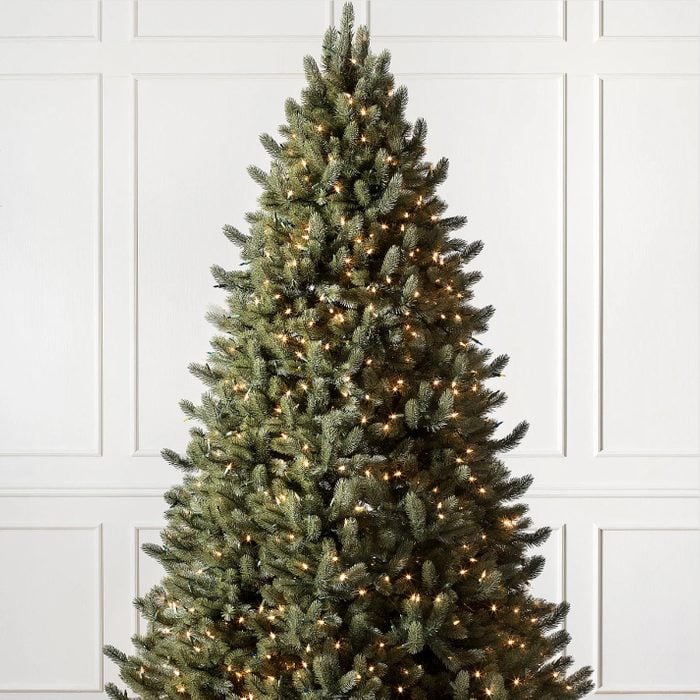 Vermont White Spruce
Vermont White Spruce
Best Variety
Vermont White Spruce
I’ll admit: I’m a Christmas-tree-in-every-room person. If you, too, want a tree for every space, look no further than the Balsam Hill Vermont White Spruce. This beauty has one of the most impressive height ranges we’ve seen, with options starting at 4.5 feet and going up to a whopping 18 feet. Whew! Each size also includes several light options.
Like all of the trees on this list, the Vermont White Spruce is incredibly lifelike, with branches that slope slightly upward to support ornaments of all shapes and sizes. Reviewers mention that, while this tree does take time to fluff, its beauty is well worth the effort.
Pros
- Incredible range of 10 heights to fit any space
- Full, classic Christmas tree shape
- Most popular Balsam Hill tree
- Branches slope upwards to hold a variety of ornament shapes and sizes
Cons
- Requires a lot of fluffing
- Larger sizes are more difficult to set up
 Alpine Balsam Fir Tree
Alpine Balsam Fir Tree
Best Sparse
Alpine Balsam Fir Tree
In our testing, we learned that alpine-style Christmas trees are pretty polarizing. Some people love ’em while others question who bought the Charlie Brown tree. If you’re in the former camp, the Balsam Hill Alpine Balsam Fir Tree is a must-see.
We love this tree’s sparse shape that is just begging to display your favorite ornaments. It’s a great option for ornament collectors (hello, Shiny-Brite!) or anyone who wants a retro-inspired look. Reviewers mention this tree is light and easy to set up, and that it’s excellent for small spaces. Get it in six heights, ranging from 4.5 feet to 12 feet. Just note that the Alpine Fir tree only comes with fairy light options.
Pros
- Dainty, whimsical tree shape
- Slender construction allows ornaments to shine
- Six height options
- Realistic trunk
Cons
- Only one light option
What to Look for When Buying Balsam Hill Christmas Trees

There’s no denying that a Balsam Hill Christmas tree is an investment. But with proper care, your tree should last several seasons—which is why it’s crucial to find the right fit for your family. Here are the key considerations when buying a Balsam Hill Christmas tree.
- Height: Balsam Hill Christmas trees range from 4.5 feet to 18 feet, with many options in between. In the trees we tested, we found them to be true to size. Make sure you measure your ceilings and consider how much space you’d like your tree to occupy. Remember: More height typically means more width too!
- Lights: One of the core components of any Christmas tree, Balsam Hill has multiple types and colors of lights—plus unlit options if you’d like to add your own. We’ve tested an assortment of options, including the Candlelight Clear LED lights and Twinkly Light Show lights and can confirm they’re both beautiful.
- Inclusions: In the 15+ Christmas trees I’ve tested, Balsam Hill trees frequently come with inclusions that make the setup and take-down process easier. While it depends on the tree and light type, expect to find storage bags, fluffing gloves, extra fuses and bulbs, remotes, instructions and other add-ons. Take a peek at the “what’s in the box” listing to find exact inclusions for the tree model you’re interested in.
- Warranty: All non-clearance Balsam Hill trees feature a three-year limited warranty that protects against mechanical and light failures (excluding burned-out bulbs). This best-in-class coverage can provide additional peace of mind.
Why You Should Trust Us
Taste of Home has helped readers create holiday magic for 30 years. In more recent history, we’ve tested and approved all sorts of holiday goodies—from Advent calendars and holiday cookies to, of course, Christmas trees—in our Milwaukee studio and editors’ homes. Combined, our testers have decades of experience and are experts at cultivating meaningful holiday moments.
How We Found the Best Balsam Hill Christmas Trees
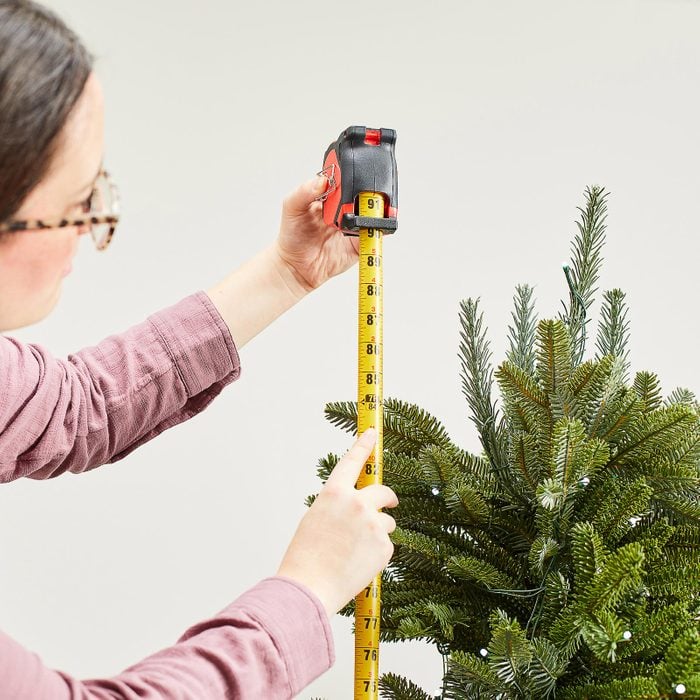
To find the best Balsam Hill Christmas trees, we spent countless hours researching and reading reviews. We evaluated specs, light options, shape and branch structure. We then called in three of our front-runners for thorough, in-person testing, split between our Milwaukee studio and editors’ homes. Our testing involved timing setup and fluffing, hanging ornaments of different weights, measuring and packing the tree away. We also read up on the brand’s trusty warranty—and even contacted customer service for troubleshooting support.
FAQ
Is Balsam Hill owned by Hallmark?
No. While Balsam Hill products make frequent appearances in Hallmark Channel programming, the brands are separate. Balsam Hill is owned by Balsam Brands.
What is so good about Balsam Hill trees?
For starters, the selection. Christmas trees are personal, and Balsam Hill ensures there’s a beautiful option for every space and style. Beyond that, these luxurious Christmas trees are top-of-the-line, crafted with quality and realism in mind. They’re designed to last for many years, and each tree is backed by a three-year warranty.
Can I put my Balsam Hill tree outside?
No. Most Balsam Hill trees are designed for indoor use, with the exception of the Oakville Outdoor Christmas Tree.

